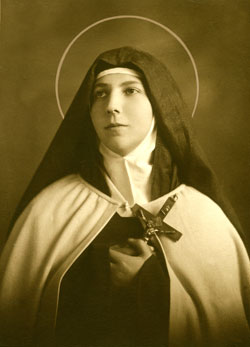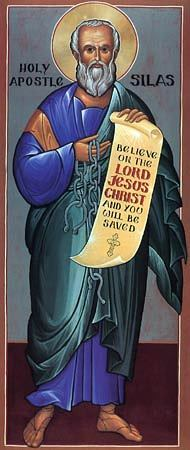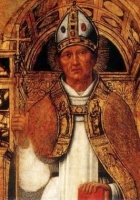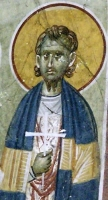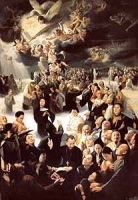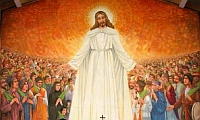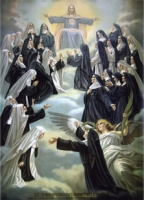St. Teresa de los Andes
ஆண்டெஸ் நகர் இயேசுவின் புனித தெரசா
(1900-1920)
இவர் சிலி நாட்டில் உள்ள சந்தியாகு என்ற நகரில் பிறந்தவர். இவருடைய பெற்றோர் வசதியானவர்கள். ஆனாலும், இறைவன் மீது மிகுந்த நம்பிக்கை கொண்டவர்களாகத் திகழ்ந்தார்கள்.
இதனாலேயே அவர்கள் இவரை இறைநம்பிக்கையிலும் பிறரன்பிலும் நல்ல முறையில் வளர்த்து வந்தார்கள்.
சிறுவயதில் முன் கோபக்காரராக இருந்த இவர், படிப்படியாக வளர்ந்து வந்தபோது, கோபம் கொள்வதை அப்படியே குறைத்துக்கொண்டார்.
இதற்குப் பிறகு இவர் கார்மேல் சபையில் சேர்ந்து துறவியானார். துறவு மடத்தில் இவரது வாழ்க்கை பலருக்கும் எடுத்துக்காட்டாக இருந்தது.
ஆனால், யாரும் எதிர்பாராதவிதமாக இவர் துறவியான அடுத்த ஆண்டிலேயே தீராத நோயினால் பாதிக்கப்பட்டு, இறையடி சேர்ந்தார்.
இவர் இறக்கும்போது இவருக்கு வயது வெறும் 20 தான். இவருக்கு புனித திருத்தந்தை இரண்டாம் ஜான் பால் 1993 ஆம் ஆண்டு, மார்ச் திங்கள் 21 ஆம் நாள் புனிதர் பட்டம் கொடுத்தார்.
இவர் இளைய தலைமுறையினருக்குப் பாதுகாவலியாக இருக்கிறார்.
Born Juana Enriqueta Josephina de Los Sagrados Corazones Fernández Solar
13 July 1900
Santiago, Chile
Died 12 April 1920 (aged 19)
Los Andes, Valparaíso, Chile
Venerated in Catholic Church
Beatified 3 April 1987, O'Higgins Park, Santiago, Chile by Pope John Paul II
Canonized 21 March 1993, Saint Peter's Square, Vatican City by Pope John Paul II
Major shrine Shrine of Saint Teresa of Los Andes
Feast
12 April
13 July (Discalced Carmelites)
Attributes Discalced Carmelite habit, crucifix
Discalced Carmelite mystic and the first Chilean to be beatified or canonized. She was baptized Juanita Fernandez Solar and born in Santiago, Chile on July 13, 1900. Devoted to Christ from a very young age, she entered the Discalced Carmelite monastery at Los Andes on May 7, 1919. There she was given the religious name of Teresa of Jesus. She died on April 12, of the following year, having made her religious profession as a Carmelite. A model for young people, Teresa was beatified in 1987 in Santiago, Chile, and was canonized by Pope John Paul II on March 21, 1993.
St. Silas
Died 65–100 AD
Macedonia
Venerated in
Roman Catholic Church
Eastern Catholic Churches
Eastern Orthodoxy
Oriental Orthodox
Anglicanism
Lutheranism
Feast
January 26 (Evangelical Lutheran Church in America, Episcopal Church)
February 10 (Lutheran Church–Missouri Synod)
July 13 (Roman Martyrology)
July 30 (Eastern Orthodoxy)
July 13 (Syriac, Malankara Calendars)
Attributes Christian Martyrdom
One of the leaders of the Church of Jerusalem, Silas was sent with Paul and Barnabas to Antioch to communicate the decisions of the Council of Jerusalem to the Gentile community in Syria. When Paul and Barnabas quarreled over John Mark, Silas was chosen by Paul to accompany him on his second missionary journey to Syria, Cilicia, and Macedonia. Silas was beaten and imprisoned with Paul at Philippi, was involved with Paul in the riot of Jews at Thessalonica that drove Paul and Silas from the city to Beroea, remained at Beroea with Timothy when Paul left, but rejoined him at Corinth. The Silvanus mentioned with Timothy by Paul and who helped him preach at Corinth is believed to be the same as Silas, since Silvanus is a Greek variant of the Semitic Silas. Silvanus is also mentioned as the man through whom Peter communicated and is considered by some scholars to be the author of that epistle. Tradition says he was the first bishop of Corinth and that he died in Macedonia. His feast day is July 13th.
Silas or Silvanus (/ˈsaɪləs/; Greek: Σίλας/Σιλουανός; fl. 1st century AD) was a leading member of the Early Christian community, who according to the New Testament accompanied Paul the Apostle on his second missionary journey.[1]
Name and etymologies
Silas is traditionally assumed to be the same as the Silvanus mentioned in four epistles. Some translations, including the New International Version, call him "Silas" in the epistles. Paul, Silas, and Timothy are listed as co-authors of the two New Testament letters to the Thessalonians, though the authorship is disputed. The Second Epistle to the Corinthians mentions Silas as having preached with Paul and Timothy to the church in Corinth (1:19), and the First Epistle of Peter describes Silas as a "faithful brother" (5:12).
There is some disagreement over the original or "proper" form of his name: "Silas", "Silvanus", "Seila", and "Saul" seem to be treated at the time as equivalent versions of the same name in different languages, and it is not clear which is the original name of "Silas", and which is a translation or equivalent nickname, or whether some references are to different persons with equivalent names. He is consistently called "Silas" in the Acts of the Apostles, but the Roman name Silvanus (which means "of the forest") is always used by Paul and in the First Epistle of Peter (5:12); it may be that "Silvanus" is the Romanized version of the original "Silas",[2] or that "Silas" is the Greek nickname for "Silvanus".[2] Silas is thus often identified with Silvanus of the Seventy. Catholic theologian Joseph Fitzmyer further points out that Silas is the Greek rendition of the Aramaic Seila (שְׁאִילָא), a version of the Hebrew Saul (שָׁאוּל), which is attested in Palmyrene inscriptions.[3]
Biblical narrative
Silas is first mentioned in Acts 15:22, where he and Judas Barsabbas (known often as 'Judas') were selected by the church elders to return with Paul and Barnabas to Antioch following the Jerusalem Council. Silas and Judas are mentioned as being leaders among the brothers, prophets and encouraging speakers. Silas was selected by Paul to accompany him on his second mission after Paul and Barnabas split over an argument involving Mark's participation. It was during the second mission that he and Paul were imprisoned briefly in Philippi, where an earthquake broke their chains and opened the prison door. Silas is thus sometimes depicted in art carrying broken chains.[4] Acts 16:25-37.
According to Acts 17–18, Silas and Timothy travelled with Paul from Philippi to Thessalonica, where they were treated with hostility in the synagogues by some traditional Jews. The harassers followed the trio to Berea, threatening Paul's safety, and causing Paul to separate from Silas and Timothy. Paul travelled to Athens, and Silas and Timothy later joined him in Corinth.[5]
These events can be dated to around AD 50: the reference in Acts 18:12 to Proconsul Gallio helps ascertain this date (cf. Gallio inscription).[6] According to Acts 18:6–7, Paul ceased to attend the synagogue in Corinth as a result of Jewish hostility, Silas is not mentioned thereafter in the Acts narrative.
He appears in the salutation of 1 and 2 Thessalonians, and is referred to in 2 Corinthians 1:19. This is as expected, as we read of his involvement in Paul's mission when these cities were visited. He also appears in the conclusion of 1 Peter at 5:12, and is perhaps the amanuensis. Peter says he regards Silas as "a faithful brother".
Mysticism
Anne Catherine Emmerich recounts in her visions that Silas' original name was Sela, and that he was one of the three "secret disciples," along with Hermas, who had later accompanied Jesus on his trip to the Three Kings' homeland near Ur, and thence to Heliopolis, and whose parents had come with the caravan of the Three Kings.[7]
Veneration
Saint Silas is celebrated in the Calendar of Saints of the Evangelical Lutheran Church in America and that of the Episcopal Church (United States) with a Lesser Feast[8] on January 26 with Timothy and Titus, and separately on July 13 by the Roman Catholic Church and February 10 by the Lutheran Church–Missouri Synod. Saint Silas is also venerated by the Eastern Orthodox Church on July 30 along with the Apostles Silvanus, Crescens, Epenetus, and Andronicus and on January 4 where he is venerated with all the apostles
Blessed Carlos Manuel Cecilio Rodriguez Santiago
Additional Memorial
4 May (Puerto Rico, based on the day of his baptism)
Profile
Second of five children born to Manuel Baudilio Rodriguez and Herminia Santiago; theirs was a pious family as one of his sisters is a Carmelite nun, one brother a Benedictine monk, the first Puerto Rican to be an abbot. When Carlos was six years old, the family store and home were burned to the ground, and the Rodriguezes moved in with his mother's family. Carlos spent time with his pious maternal grandmother Alexjandrina Esteras who was a significant influence on him. At age 9, Carlos wrestled a rabid dog that had snatched up his 1-year-old cousin; Carlos was badly wounded in the fight, but his cousin survived to live a long life. Carlos suffered from ulcerative colitis from age 13, which interrupted a brilliant scholarly career; he completed high school, but it was several years before he could move on to college.
Carlos never passed up a chance to serve as an altar boy. He worked as an office clerk until 1946, and tried to attend the University of Puerto Rico, but his health prevented it. After receiving a few lessons, he taught himself to play piano and organ, and loved to spend days hiking in the countryside.
Worked as an office clerk at Caguas, Puerto Rico, and at the University of Puerto Rico Agriculture Experiment Station. Part of his works was as a translator, converting English documents to Spanish. He then used his translating skills to write, and with his modest salary to publish, the magazines Liturgy and Christian Culture. With the help of Father McWilliams, he founded a Liturgy Circle at Caguas. With Father McGlone, he organized the chorus Te Deum Laudamus.
Carlos's principal apostolic work was at Catholic University Center, Rio Piedras, Puerto Rico where he evangelized to students and teachers. He organized another Liturgy Circle (Circulo de Cultura Christiana: Christian Culture Circle), and published Christian Life Days to help university students enjoy the liturgical seasons. A member of the Brotherhood of Christian Doctrine, Holy Name Society, and Knights of Columbus, he taught catechism to high school students, encouraged liturgical renewal among clergy and laity, and worked for active participation of the laity, the use of vernacular language, and devotion to the Paschal Vigil – all prior to Vatican II.
As the years went by, his health declined further. He suffered from rectal cancer, and the misery of aggressive surgery in 1963. At one point in this misery he felt himself abandoned by God, but soon rediscovered his faith and enthusiasm, and was an example to all of joy in the midst of suffering.
Born
22 November 1918 at Caguas, Puerto Rico
Died
13 July 1963 of cancer at Caguas, Puerto Rico
Beatified
• 29 April 2001 by Pope John Paul II
• the miraculous cure of a patient's non-Hodgkins malignant lymphoma in 1981 is attributed to him
• his Cause is unique, being carried forward by the laity
• first Puerto Rican blessed
• first Caribbean layman blessed
Blessed Mariano de Jesus Eues Hoyos
Also known as
Padre Marianito
Profile
Eldest son of a religious rural Colombian family in a time when the state was hostile to the Church. From age 16 he wanted to become a priest; he entered the new Medellin Seminary at age 24, and was ordained in 1872. Worked in the parishes of San Pedro and Yarumel, and in 1878 he was assigned as priest to Angostura, Colombia where he spent the rest of his life.
Mariano had a great love for the poor, especially rural labourers. His preaching was simple and effective, his time spent ministering to the spiritual and social needs of his flock, and the people who knew him considered him a saint in life. However, his parish was in an area beset by civil war, and neither side seemed sympathetic to the Church; several times Mariano had to hide in nearby caves to escape the fighting.
Padre Marianito was beatified after confirmation of a miracle in the life of Father Rafael Gildardo Velez Saldarriaga of Medellin. Velez underwent prostate surgery in 1970; in 1982 he developed cancer on the scar. He had surgery, cobalt and estrogen therapies, and seemed to have recovered. In March 1987 he developed an oedema of the legs that turned into elephantiasis followed by metastasis of the spinal column, and the 75 year old priest was pronounced terminal. But in September 1987 he began to improve. In two months the oedema was reduced, the cellulitis and bone metastasis had disappeared. Doctors and scientists examined Father Velez in June 1991, and declared his cure had no scientific explanation. Additional analyses carried out in 1997 showed complete recovery, and on 4 April 1998, the Medical Commission of the Vatican Congregation for the Causes of Saints acknowledged unanimously that the priest's cure could not be scientifically explained, and was attributed to Padre Marianito's intercession.
Born
14 October 1845 at Yarumal, diocese of Antioquía, Colombia
Died
13 July 1926 at Angostura, Antioquia, Colombia of severe urinary system infections
Beatified
• 9 April 2000 by Pope John Paul II
• first Colombian to be beatified
Saint Henry II
புனித இரண்டாம் ஹென்றி(St.Henry)
அரசர்
பிறப்பு : 973
பவேரியா (Bavaria), ஜெர்மனி
இறப்பு : 1024
பாம்பர்க்(Bamberg), ஜெர்மனி
புனிதர்பட்டம்: 1146, திருத்தந்தை 3 ஆம் யூஜின்
இவர் பவேரியா நாட்டு அரசராக 995 ல் உரோம் பேரரசின் மன்னராக 1002 ல் உயர்வுப்பெற்றார். திருச்சபையின் நலனுக்காகவும், வளர்ச்சிக்காகவும் போர்களில் ஈடுபடத் தயங்காதவர். இவர் துறவற மடத் தலைவர்களையும், ஆயர்களையும் நியமனம் செய்யும் அதிகாரத்தை பெற்றிருந்தார். இவரின் துணைவியாரும் புனித வாழ்க்கை வாழ்ந்து புனிதர் பட்டம் பெற்றார். உரோம் நகரில் ஏற்பட்ட கலகத்தை நசுக்க திருத்தந்தை 8ஆம் ஆசீர்வதிப்பருக்கு மன்னர் உறுதுணையாயிருந்தார். இவர் மற்ற நாடுகளில் அமைதி நிலவ அரும்பாடுபட்டார்.
இவர் தன் நாட்டு மக்களுக்கு பின்வரும் இறைவசனத்தை அடிக்கடி கூறிவந்தார். "அழிந்து போகும் செல்வத்தை துறந்துவிட்டு என்றும் அழியா, நிலையான செல்வத்தை வான்வீட்டில் சேர்த்து இடத்தை தக்க வைத்துக்கொள்ளவேண்டும்" என்பதை மறக்கக்கூடாது என்பார். இவ்வுலகில் நாம் பெறும் புகழ் புகையாக மறைந்துவிடும். எனவே நிலையான பேரின்பத்தை அடைய முயற்சிக்கவேண்டும் என்று அடிக்கடி கூறுவார். தன் நாட்டில் கடவுளின் இரக்கத்தைப் பெற, பெரிய பெரிய ஆலயங்களைக் கட்டினார். அவற்றின் பராமரிப்பிற்காக செல்வங்களை வாரி வழங்கினார். பாக்பெர்கில்லிருந்து பணத்தை செலவிட்டார். இறுதிவரை இறைப்பணியாற்றி அவ்வாலய பணியின்போதே உயிர் துறந்தார்.
Also known as
• Good King Henry
• Heinrich, Duke of Bavaria
Profile
Son of Gisella of Burgundy and Henry II the Quarrelsome, Duke of Bavaria. Educated at the cathedral school in Hildesheim by bishop Wolfgang of Regensburg. Became Duke of Bavaria himself in 995 upon his father's death, which ended Henry's thoughts of becoming a priest. Ascended to the throne of Germany in 1002. Crowned King of Pavia, Italy on 15 May 1004. Married Saint Cunegunda, but was never a father. Some sources claim the two lived celibately, but there is no evidence either way.
Henry's brother rebelled against his power, and Henry was forced to defeat him on the battlefield, but later forgave him, and the two reconciled. Henry was crowned Holy Roman Emperor in 1014 by Pope Benedict VIII; he was the last of the Saxon dynasty of emperors. Founded schools, quelled rebellions, protected the frontiers, worked to establish a stable peace in Europe, and to reform the Church while respecting its independence. Fostered missions, and established Bamberg, Germany as a center for missions to Slavic countries. Started the construction of the cathedral at Basel, Switzerland; it took nearly 400 years to complete. Both Henry and Saint Cunegunda were prayerful people, and generous to the poor.
At one point he was cured of an unnamed illness by the touch of Saint Benedict of Nursia at Monte Cassino. He became somewhat lame in his later years. Widower. Following Cunegunda's death, he considered becoming a monk, but the abbot of Saint-Vanne at Verdun, France refused his application, and told him to keep his place in the world where he could do much good for people and the advancement of God's kingdom.
Born
6 May 972 at Albach, Hildesheim, Bavaria, Germany
Died
13 July 1024 at Pfalz Grona, near Göttingen, Saxony (in modern Germany) of natural causes
Canonized
1146 by Pope Blessed Eugene III
Patronage
• against sterility
• childless people
• disabled, handicapped or physically challenged people
• dukes
• kings
• people rejected by religious orders
• diocese of Bamberg, Germany
• Basel, Switzerland
• Benedictine Oblates
Blessed Ferdinando Maria Baccilieri
Profile
Raised in a pious family, he was educated by the Barnabites in Bologna, Italy and the Jesuits in Ferrara, Italy. Jesuit novice in Rome, Italy in 1838, but health problems force him to drop out and return home. When he improved, he studied theology in Ferrara, and was ordained in 1844.
Noted spiritual director and preacher of home missions. He taught Italian and Latin at the seminary in Finale Emilia, Italy, and studied civil and canon law at the Pontifical University of Bologna, Italy. In 1851 the Archbishop of Bologna asked him to administer a troubled parish in Galeazza, Italy. He was so successful at renewing his flock that he was appointed him the parish priest; he stayed for 41 years.
In 1867 Father Ferdinand lost his voice, and was forced to write out his lessons and have others deliver them. With his public work restricted, he concentrated on one-to-one spiritual direction, hearing confessions up to 16 hours at a time. His direction, and his personal holiness, attracted so many spiritual students that without his planning it, a religious congregation formed around the parish. The Confraternity of the Sorrowful Mother was founded to teach poor girls in the area. Later, the Servite Third Order was established. In 1862 he opened a small convent for the members, and in 1866 they were formalized under the rule of the Mantellate Servile Sisters of Rome; the community was approved by the Archbishop of Bologna in 1899, and by the Vatican in 1919. The Confraternity continues its work today in Italy, Germany, Brazil, South Korea and the Czech Republic.
Born
14 May 1821 in Campodoso (modern Modena), Italy
Died
13 July 1893 of natural causes
Beatified
3 October 1999 by Pope John Paul II
Saint Giustina of Arzano
Additional Memorial
3rd Sunday of September (procession commemorates the attempted movement of her relics)
Profile
Young Christian woman in Trieste, Italy who had consecrated herself to God during a period of persecution. A pagan friend of the city's imperial consol Fabiano sought Giuliana in marriage, but she refused, and was discovered to be a Christian. She was arrested, ordered to renouce her faith, and when she would not, sentenced to death. Martyr.
Died
• arrows fired at her would not strike her, and the archers would suddenly sweat blood
• beheaded in Trieste, Italy
• her body was transported to a planned burial site in Sicily, Italy; when the ox pulling the cart reached Arzano, Italy, it refused to go further; the people took this as a sign that the saint wished to stay there
• skull enshrined in a glass case in the church of San Martino in Torre d'Arese, Italy
• legend says that on the 3rd Sunday of September in 1670, the bishop of Pavia, Italy tried to take her relics to his city; when he reached the city limits of Arzano, a massive thunderstorm began, stopping the travellers; if they retreated back into the city, the storm would lessen; when they approached the limits again, it would get worse; when the bishop returned the relics to their original location, the storm stopped and the sun came out; a procession of her relics is still held on the 3rd Sunday in September, but they people are careful never to leave the city limits
Patronage
• Arzano, Italy
• unmarried girls (in Torre d'Arese, Italy)
Blessed James of Voragine
Also known as
• James of Varazze
• James of Viraggio
• James of Genoa
• Giacomo, Jacob, Jacobus, Jacopo
Profile
Dominican in 1244 at age 14. Taught theology and Bible study. Prior of his house in Genoa, Italy. Provincial of Lombardy from 1267 to 1286 where he was a noted preacher. Chosen archbishop of Genoa in 1286, but refused the position. Genoa was placed under interdict for supporting a revolt against the King of Naples; Pope Nicholas IV apppointed James to raised the interdict in 1288. Again chosen archbishop of Genoa in 1292, and this time he was ordered to accept.
He tried to reconcile the warring Guelphs and Ghibellines, was generous to the poor, built and repaired churches, monasteries, and hospitals. He worked to insure clerical discipline, and is reported to have translated the Bible into Italian, though no copies have survived. Wrote the Legenda Aurea Sanctorum (The Golden Legend), a collection of scores of tales of the saints; it has become an invaluable source for information on the middle ages, and reading it led Saint Ignatius of Loyola to a conversion experience.
Born
c.1226 at Varazze (modern Voragine), diocese of Savona, Italy (near Genoa)
Died
13 July 1298 in Genoa, Italy of natural causes
Beatified
11 May 1816 by Pope Pius VII (cultus confirmation)
Saint Mildred of Thanet
Also known as
• Mildred of Minster
• Mildthryth...
Memorial
• 18 May (translation of relics)
• 20 February (translation of relics)
Profile
Daughter of Merewalh, King of Mercia, and Saint Ermenburga of Thanet. Sister of Saint Milburga and Saint Mildgytha. Educated at the convent school of Chelles, near Paris, France. Rejected an offer of marriage, and entered the convent of Minster on the Isle of Thanet, a house which was founded by her mother, is still in use, and is one of the oldest continuously occupied structures in Britain. Benedictine nun. Worked with Saint Theodore of Canterbury. Abbess at Minster where one of her novices of Saint Edburga. Noted for her generosity to the poor, and special attention to social outcasts. Yearly pilgrimages to her relics at Minster continue to today.
Died
• c.700 of natural causes
• relics first enshrined at Canterbury, England
• relics translated to Deventer, the Netherlands
• part of the relics have been translated to Minster, England
Canonized
1388 by Pope Urban VI
Representation
• Benedictine nun accompanied by a hart, usually white
• Benedictine nun holding a church
• Benedictine nun with three geese
Esdras the Prophet
Also known as
Ezra
Profile
Priest and scribe who left Babylon in the 7th year of Artaxerxes (458 B.C.) with a caravan of 1,800 Jewish exiles, to return to Jerusalem. The Persian king had given Esdras a letter ordering the satraps beyond the Euphrates to aid him to enforce observance of the Mosaic Law in Judea. Esdras brought with him an exemption from taxation for the temple officials, and gifts from Artaxerxes and the Jews of Babylon. With these the temple worship was to be enhanced and subsidized. Within a year mixed marriages, of which even priests had been guilty, were dissolved. In 444 B.C., after the walls of Jerusalem had been rebuilt, the Law was read to the assembled multitude, whereupon the Feast of Tabernacles and the Day of Atonement were observed. There followed the renewal of the Covenant, which all solemnly agreed to keep. By Esdras and Nehemias the restoration of the Law was effected. The measures which Esdras himself effected determined in great part the organization and practise of later Judaism. The Talmud assigns to him the compilation of the Books of Paralipomenon. He is also credited with the collection of the canonical books of the Old Testament extant in his time. Jewish tradition regards him as the author of the Books of Esdras.
Saint Clelia Barbieri
Also known as
Cloelia Barbieri
Profile
From her earliest life, Clelia paid no attention to this world, focused solely on the spiritual life. Founded the Little Sisters of the Mother of Sorrows who concentrate on ministering in hospitals and elementary schools to the sick, the aged, the lonely, and a prayer ministry for the poor. Since her death, her voice has been heard in the houses of her order, accompanying her sisters in song.
Born
13 February 1847 at Bundrie di San Giovanni, Persiceto, Italy
Died
13 July 1870 at Bologna, Italy of tuberculosis
Canonized
9 April 1989 by Pope John Paul II
Patronage
• Little Sisters of the Mother of Sorrows
• people ridiculed for their piety
Blessed Berthold of Scheide
Also known as
Berthold of Scheda
Profile
Older brother of Blessed Menrich of Lübeck. Priest. Member of the Premonstratensians. Lay brother at the Scheide monastery near Fröndenberg-on-der-Ruhr, Westphalia (in modern Germany). Hermit at Berg Haslei. There he started speaking out against immorality, standing in the shade of a large oak tree where so many would-be spiritual students gathered that he built a hermitage and chapel to minister to them; that chapel had an image of the Blessed Virgin Mary that his father had brought from the Holy Land. With Blessed Menrich, he founded the Cistercian convent of Vrundeberg Abbey in Westphalia.
Born
12th century near Lübeck, Schleswig-Holstein (in modern Germany)
Died
• c.1214 of natural causes
• buried at the Scheda monastery near Fröndenberg-on-der-Ruhr, Westphalia (in modern Germany)
Blessed Thomas Tunstal
Also known as
• Thomas Helmes
• Thomas Dyer
Additional Memorial
29 October as one of the Martyrs of Douai
Profile
Benedictine. Studied at the seminary in Douai, France. Priest. He returned to England to minister to covert Catholics, using false names to hide from the authorities. Martyred for the crime of priesthood in the persecutions of King James I.
Born
Norwich, Norforlk, England
Died
hanged on 13 July 1616 in Tyburn, London, England
Beatified
15 December 1929 by Pope Pius XI
Saint Eugene of Carthage
Also known as
Eugenius
Profile
Bishop of Carthage, North Africa in 481. Exiled to the desert of Tripoli with many of his parishioners, some of them children, by Arian Vandals. They were allowed to return in 488, but Eugene was exiled again in 496, and he eventually settled in Albi, Italy.
Died
505 in Albi, Italy of the mistreatment suffered in exile
Saint Serapion of Alexandria
Also known as
Serapione
Profile
Martyred in the persecutions of emperor Septimius Severus and governor Aquila.
Died
burned alive c.248 in Alexandria, Egypt
Saint Myrope
Profile
Noted for her many pilgrimages to the graves of martyrs. Hid the relics of Saint Isidore from persecutors, for which action she was imprisoned and scourged.
Born
Chios, Greece
Died
c.251 in prison from the effects of torture
Saint Arno of Würzburg
Profile
Bishop of Würzburg, Germany in 855. Helped organize Crusaders from Bohemia, Moravia and Normandy. Killed by pagan Slavs while he was celebrating Mass. Martyr.
Born
9th century
Died
13 July 892 at Chemnitz, Saxony (in modern Germany)
Saint Turiaf of Dol
Also known as
Thivisiau, Tuien, Turiav, Turiave, Turiavus, Turien, Turiano, Turiavo
Profile
Born to the 8th century French nobility. Monk. Abbot. Priest, ordained by Saint Sampson. Bishop of Dol, Brittany, France.
Born
in Brittany, France
Died
c.750 of natural causes
Blessed Jean of France
Profile
Mercedarian friar. Travelling through Algiers and north Africa from 1398 to 1401, he was repeatedly abused and tortured, but freed 128 Christians who had been enslaved by Muslims.
Died
1401 of natural causes
Saint Serapion of Macedonia
Profile
Zealous evangelist who brought many pagans to the faith. Martyred in the persecutions of Septimus Severus.
Died
burned alive c.195, probably in Macedonia
Saint Salutaris of Carthage
Profile
Exiled from Carthage, North Africa to the desert of Tripoli by Arian Vandals. Martyr.
Died
505
Saint Muritta of Carthage
Profile
Exiled from Carthage, North Africa to the desert of Tripoli by Arian Vandals. Martyr.
Died
505
Saint Dogfan
Also known as
Doewan
Profile
Son of the chieftain Saint Brychan of Brycheiniog. Martyr.
Died
5th century in Dyfed, Wales
Saint Sarra of Egypt
Profile
Fifth-century desert hermitess in Egypt known for her piety, discipline and extremely ascetic life.
Saint Paulus Liu Jinde
Also known as
Baolu, Paul
Additional Memorial
28 September as one of the Martyrs of China
Profile
Married layman in the apostolic vicariate of Southeastern Zhili, China. During the persecutions of the Boxer Rebellion, all the other members of his village renounced Christianity to save their lives. Paulus, instead, went out to meet the Boxers with a rosary and prayer book. Martyr.
Born
c.1821 in Lanziqiao, Hengshui, Hebei, China
Died
13 July 1900 in Lanziqiao, Hengshui, Hebei, China
Canonized
1 October 2000 by Pope John Paul II
Saint Iosephus Wang Kuiju
Also known as
• Joseph Wang Guiji
• Ruose
Memorial
28 September as one of the Martyrs of China
Profile
Layman in the apostolic vicariate of Southeastern Zhili, China. Martyred in the Boxer Rebellion.
Born
c.1863 in Nangong, Jizhou, Hebei, China
Died
13 July 1900 in Nangong, Jizhou, Hebei, China
Canonized
1 October 2000 by Pope John Paul II
Blessed Thérèse-Henriette Faurie
Also known as
Marie of the Annunciation
Additional Memorial
9 July as one of the Martyrs of Orange
Profile
Sacramentine nun. Martyred in the French Revolution.
Born
13 February 1770 in Sérignan, Vaucluse, France
Died
guillotined on 13 July 1794 in Orange, Vaucluse, France
Beatified
10 May 1925 by Pope Pius XI
Blessed Élisabeth Verchière
Also known as
Madeleine of the Mother of God
Additional Memorial
9 July as one of the Martyrs of Orange
Profile
Sacramentine nun. Martyred in the French Revolution.
Born
2 January 1769 in Bollène, Vaucluse, France
Died
guillotined on 13 July 1794 in Orange, Vaucluse, France
Beatified
10 May 1925 by Pope Pius XI
Blessed Marie-Anastasie de Roquard
Also known as
Sister Saint Gervase
Additional Memorial
9 July as one of the Martyrs of Orange
Profile
Ursuline nun. Martyred in the French Revolution.
Born
5 October 1749 in Bollène, Vaucluse, France
Died
guillotined on 13 July 1794 in Orange, Vaucluse, France
Beatified
10 May 1925 by Pope Pius XI
Blessed Anne-Andrée Minutte
Also known as
Sister Saint Alexis
Additional Memorial
9 July as one of the Martyrs of Orange
Profile
Sacramentine nun. Martyred in the French Revolution.
Born
4 February 1740 in Sérignan, Vaucluse, France
Died
guillotined on 13 July 1794 in Orange, Vaucluse, France
Beatified
10 May 1925 by Pope Pius XI
Blessed Marie-Anne Lambert
Also known as
Sister Saint Francis
Additional Memorial
9 July as one of the Martyrs of Orange
Profile
Ursuline nun. Martyred in the French Revolution.
Born
17 August 1742 in Pierrelatte, Drôme, France
Died
guillotined on 13 July 1794 in Orange, Vaucluse, France
Beatified
10 May 1925 by Pope Pius XI
Blessed Marie-Anne Depeyre
Also known as
Saint Saint Frances
Additional Memorial
9 July as one of the Martyrs of Orange
Profile
Ursuline nun. Martyred in the French Revolution.
Born
2 October 1756 in Tulette, Drôme, France
Died
guillotined on 13 July 1794 in Orange, Vaucluse, France
Beatified
10 May 1925 by Pope Pius XI
Blessed Barthélemy Jarrige de La Morelie de Biars
Profile
Priest of the diocese of Limoges, France. Imprisoned on a ship in the harbor of Rochefort, France and left to die during the anti-Catholic persecutions of the French Revolution. One of the Martyrs of the Hulks of Rochefort.
Born
18 March 1753 in Moutier, Haute-Vienne, France
Died
13 July 1794 aboard the prison ship Deux-Associés, in Rochefort, Charente-Maritime, France
Beatified
1 October 1995 by Pope John Paul II
Blessed Louis-Armand-Joseph Adam
Profile
Franciscan Capuchin priest. Imprisoned on a ship in the harbor of Rochefort, France and left to die during the anti-Catholic persecutions of the French Revolution. One of the Martyrs of the Hulks of Rochefort.
Born
19 December 1741 in Rouen, Seine-Maritime, France
Died
13 July 1794 aboard the prison ship Deux-Associés, in Rochefort, Charente-Maritime, France
Beatified
1 October 1995 by Pope John Paul II
Saint Emanuele Lê Van Phung
Also known as
Emmanuel Le Van Phung
Memorial
24 November as one of the Martyrs of Vietnam
Profile
Married layman in the apostolic vicariate of West Cochinchina (in modern Vietnam). Father and catechist; he built a church, a convent for the Daughters of Mary, a home for missionaries, and a college. Arrested on 7 January 1859 in the persecutions of emperor Tu-Duc for the crime of harboring a priest. While in prison, Emmanuele continued to urge his family to cling to their faith and show charity to the persecutors. Martyr.
Born
c.1796 in Ðau Nuoc, Cù Lao Giêng, Vietnam
Died
• beheaded on 13 July 1859 in Châu Ðoc, An Giang, Vietnam
• buried in Ðau Nuoc, Cù Lao Giêng, Vietnam
Canonized
19 June 1988 by Pope John Paul II
Martyrs of Cyprus
Profile
300 Christians who retired to Cyprus to live as cave hermits, devoting themselves to prayer and an ascetic life devoted to God. Tortured and martyred for their faith, and their bodies dumped in the various caves in which they had lived. We know the names of five of them, but no other details even about them – Ammon, Choulélaios, Epaphroditus, Eusthénios and Héliophotos.
Died
• beheaded in the 12th century on Cyprus
• body dumped in the cave where he had lived, and only rediscovered long afterwards
Blessed Angeline of Marsciano
Foundress and Abbess:
Born: 1377 AD
Montegiove, Umbria, Papal States
Died: July 14, 1435
Foligno, Umbria, Papal States
Venerated in:
Roman Catholic Church
(Third Order of St. Francis and the Poor Clares)
Beatified: March 8, 1825
Pope Leo XII
Major shrine:
Chiesa di San Francesco, Foligno, Perugia, Italy
Feast: July 13
The Blessed Angelina of Marsciano, T.O.R., or Angelina of Montegiove was an Italian Religious Sister and foundress and is a beta of the Roman Catholic Church. She founded a congregation of Religious Sisters of the Franciscan Third Order Regular, known today as the Franciscan Sisters of Blessed Angelina. She is generally credited with the founding of the Third Order Regular for women, as her religious congregation marked the establishment of the first Franciscan community of women living under the Rule of the Third Order Regular authorized by Pope Nicholas V.
Unlike the Second Order of the Franciscan movement, the Poor Clare nuns, they were not an enclosed religious order, but have been active in serving the poor around them for much of their history. She is commemorated by the Franciscans on June 4; her liturgical feast is July 13.
Biographical selection:
Angelina was born in 1377 in Montegiove, near Orvieto, Italy, descending from the Counts of Marsciano on her father's side and the Counts of Corbara on her mother's. At age 12 she consecrated her virginity to God, but three years later her father arranged a marriage for her with the Count of Civitella del Tronto in the Abruzzo region in the Kingdom of Naples.
The girl implored her father to let her consecrate herself to God, but her pleas were made in vain. He even threatened his daughter with death if she would not consent to marry in eight days.
Afflicted in spirit, Angelina had recourse to Our Lord, Who told her to observe the will of her father. Following this counsel, she agreed to marry the Count. The ceremony was performed with great pomp and the traditional feasting.
On the wedding night, the young lady fled to her room, filled with anguish, and knelt at the feet of a crucifix asking Our Lord to protect her. When the Count arrived, he asked the reason for her tears and she told him about her vow. Hearing this, he was touched by grace and desired to follow her example.
Therefore, he knelt beside his young spouse and promised to respect her vow and to live chastely with her as a sister. Both thanked God for the great grace they had received. Two years later, the Count died leaving Angelina free to manage her life.
Angelina entered the Third Order of St. Francis and dedicated herself to works of charity and the conversion of sinners. The many miracles she worked made her famous, which caused her to move to Civitella. When many other young ladies from great families entered Angelina's convent, the nobles of the city became displeased and complained to the King that she was opposing the married vocation. In response to these complaints, the King expelled her from his Kingdom.
She and her companions went to Assisi and then Foligno, where her community of Third Order sisters received papal approval in 1397. She had soon established 15 similar communities of women who followed the Franciscan Rule in other Italian cities. She died on July 14, 1435, as a mother of a great religious family, and was beatified in 1825.
அருளாளர் மார்ஸியானோ நகர் ஏஞ்சலின்
சபை நிறுவனர்/ மடாலய தலைவி:
பிறப்பு: கி.பி. 1357
மான்ட்டேகியோவ், ஊம்ப்ரியா, திருத்தந்தையர் மாநிலங்கள்
இறப்பு: ஜூலை 14, 1435
ஃபாலிக்னோ, ஊம்ப்ரியா, திருத்தந்தையர் மாநிலங்கள்
ஏற்கும் சமயம்:
ரோமன் கத்தோலிக்க திருச்சபை
அருளாளர் பட்டம்: மார்ச் 8, 1825
திருத்தந்தை பன்னிரெண்டாம் லியோ
முக்கிய திருத்தலம்:
சீசா டி சேன் ஃபிரேன்செஸ்கோ, ஃபோலிக்னோ, இத்தாலி
நினைவுத் திருநாள்: ஜூலை 13
“மார்ஸியானோ நகர் ஏஞ்சலின்” (Angeline of Marsciano) என்றும், “மான்ட்டேகியோவ் நகர் ஏஞ்சலினா” (Angelina of Montegiove) என்றும் அழைக்கப்படும் இவர், ஒரு இத்தாலிய கத்தோலிக்க அருட்சகோதரியும், “ஃபிரான்சிஸ்கன் மூன்றாம்நிலை சபையின் அருட்சகோதரிகளின் சபையின்” (Congregation of Religious Sisters of the Franciscan Third Order Regular) நிறுவனரும் ஆவார். இன்று இச்சபை, "அருளாளர் ஏஞ்சலினின் ஃபிரான்சிஸ்கன் அருட்சகோதரிகள் சபை" (Franciscan Sisters of Blessed Angeline) என்றழைக்கப்படுகிறது.
கி.பி. 1357ம் ஆண்டு, ஊம்ப்ரியாவிலுள்ள மூதாதையர்களின் “மான்ட்டேகியோவ்” என்னும் கோட்டையில் (Castle of Montegiove) பிறந்த இவருடைய தந்தை பெயர் “ஜாகோபோ” (Jacopo Angioballi) ஆகும். இவருடைய தாயார் “அன்னா” (Anna) ஆவார்.
தமது ஆறு வயதிலேயே தமது ஒரு சகோதரியுடன் அனாதரவாகவும் தனிமையிலும் விடப்பட்ட ஏஞ்சலினா, தமது பதினைந்து வயதில், “ஸிவிடெல்லா டெல் ட்ரொன்டோ” (Count of Civitella del Tronto) நகரின் பிரபுவான “கியோவன்னி ட டேர்னி” (Giovanni da Terni) என்பவருக்கு திருமணம் செய்து வைக்கப்பட்டார். ஆனால், இரண்டே வருடங்களில் அவரது கணவர் மரணமடைந்ததால், குழந்தைகளற்ற ஏஞ்சலினா, விதவையானார். தமது கணவரின் தோட்டங்களை நிர்வகிக்கும் பொறுப்பேற்றார்.
பின்னர், தமது வாழ்வினை இறைவனுக்கு அர்ப்பணிக்க தீர்மானித்தார். தமது திருமணத்தின் முன்னரே செயல்படுத்த விரும்பியதை இப்போது சாதித்தார். "மூன்றாம் நிலை ஃபிரான்சிஸ்கன்" சபையில் அருட்சகோதரியாக இணைந்தார்.
பல துணைவர்களுடன் இணைந்து நாட்டின் கிராமங்களில் செயல்படும் வகையில் 'அப்போஸ்தலிக்க சபை' ஒன்றினை தொடங்கினார். "மனம் திரும்புதல் மற்றும் கன்னித்தன்மையின் மதிப்புகளை" போதிக்க ஆரம்பித்தார். அத்துடன், அவசியப்படுபவர்களுக்கு தேவைப்படும் உதவிகளையும், சேவைகளையும் செய்ய ஆரம்பித்தார்.
நாட்டின் இளம்பெண்களை கத்தோலிக்க வாழ்வு வாழ அழைத்த காரணத்தால், இவர் ஒரு மந்திரவாதி என்றும், பெண்களுக்கெதிராக - திருமணம் செய்வதை தடுக்கும் வகையில் போதனைகள் செய்வதாகவும் குற்றம் சாட்டப்பட்டதால் இவரது மத போதனைகளும் செயல்பாடுகளும் தடுத்து நிறுத்தப்பட்டன. நேப்பிள்ஸ் அரசர் “லாடிஸ்லாஸ்” (Ladislas, the King of Naples) அவர்களின் முன்னர் நிறுத்தப்பட்ட ஏஞ்சலினா, தமது தரப்பு வாதங்களை எடுத்து வைத்தார். அவற்றை ஏற்றுக்கொண்ட அரசர், ஏஞ்சலினாவை குற்றச்சாட்டுக்களிலிருந்து விடுவித்தார். ஆனால், மீண்டும் பிரச்சினைகள் ஏற்படாதிருக்கும் பொருட்டு, ஏஞ்சலினாவையும் அவரது தோழர்களையும் நாடு கடத்த உத்தரவிட்டார்.
அதன்பிறகு, ஏஞ்சலினா “அசிசி” (Assisi) பயணமானார். வழியில், "ஃபிரான்சிஸ்கன் சபையின் தொட்டில்" (The Cradle of the Franciscan Order) என அழைக்கப்படும் பேராலயமான “சான்ட மரியாவில்” (Basilica of Santa Maria degli Angeli) இளைப்பாருதலுக்காகவும் செபிப்பதற்காகவும் தங்கினார். அங்கே, அவருக்கு ஆண்டவர் இயேசு காட்சியளித்தார். 'ஃபோலிக்னோ' (Foligno) என்னும் இடத்தில் “மூன்றாம் நிலை ஃபிரான்சிஸ்கன் சபையின்” (Third Order of Saint Francis) சட்டப்படி நடக்கும் “துறவியர் மடம்” ஒன்றினை தொடங்க இறைவன் கட்டளை இட்டார். இதற்கு அங்குள்ள உள்ளூர் ஆயர் ஒப்புதலளித்தார்.
கி.பி. சுமார் 1394ம் ஆண்டு “ஃபோலிக்னோ” (Foligno) என்ற இடத்தில் தங்கிய ஏஞ்சலினா, “புனித அன்னா” (St. Anna) என்ற சிறிய மடாலயத்தில் இணைந்தார். அங்கே தலைமைப் பொறுப்பினை ஏற்ற அவர், கி.பி. 1397ம் ஆண்டு, பன்னிரண்டு பெரும் சபைகளை நிறுவி, அதன் தலைமை பொறுப்பேற்றார். கி.பி. 1435ம் ஆண்டு, இவருடைய மரணத்தின் முன்னரே, இவருடைய சபை “ஃப்ளோரன்ஸ்” (Florence), “ஸ்போலேடோ” (Spoleto), “அசிசி” (Assisi) மற்றும் “விடெர்போ” (Viterbo) ஆகிய இடங்களிலும் விரிவடைந்தது.
கி.பி. 1435ம் ஆண்டு, ஜூலை மாதம், 14ம் நாளன்று, மரணமடைந்த ஏஞ்சலினா, ஃபோலிக்னோவில் (Foligno) உள்ள “புனித ஃபிரான்சிஸ் ஆலயத்தில்” (Church of St. Francis) அடக்கம் செய்யப்பட்டார்.
கி.பி. 1825ம் ஆண்டு, மார்ச் மாதம், 8ம் நாளன்று, திருத்தந்தை பன்னிரெண்டாம் லியோ (Pope Leo XII) அவர்களால் ஏஞ்சலினாவுக்கு அருளாளர் பட்டம் அளிக்கப்பட்டது.Angeline died on July 14, 1435, and was beatified in 1825. Her liturgical feast is celebrated on July 13.
Also celebrated but no entry yet
• Our Lady of Grace of Valsorda
• Our Lady of Soccorso
• Martyrs of Alexandria
• Britta of Balagny
• Cruimther Fionntain of Cill-Airthir
• Ernin of Inis-Caoin
• Ernst of Neresheim
• Fintan of Killerr
• Francesco da Casale
• Golindouch
• Maura of Balagny
• Silas
• Siree of Kurdistan
• Stephen the Hymnographer
